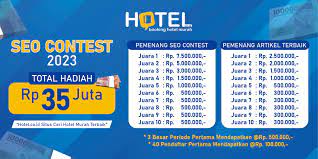In the ever-evolving digital landscape, Search Engine Optimization (lomba kontes seo) stands as a pivotal force that determines the online visibility and success of businesses. SEO is not just a buzzword; it’s a strategic approach that empowers websites to rank higher on search engine result pages (SERPs), driving organic traffic and enhancing overall online presence. In this comprehensive guide, we will explore the fundamentals of SEO, its key components, and the latest trends shaping the SEO landscape.
Understanding SEO:
SEO is the practice of optimizing a website to improve its visibility on search engines like Google, Bing, and Yahoo. The ultimate goal is to rank higher on SERPs for relevant keywords, making it easier for users to find your content, products, or services. SEO involves a combination of on-page and off-page optimization strategies to enhance the website’s relevance, authority, and user experience.
Key Components of SEO:
- On-Page Optimization:
- Title Tags and Meta Descriptions: Crafting compelling and relevant title tags and meta descriptions for each page.
- Quality Content: Creating valuable, well-structured, and keyword-rich content.
- Header Tags: Proper use of header tags (H1, H2, H3) to organize content and improve readability.
- URL Structure: Creating SEO-friendly URLs that are concise and descriptive.
- Off-Page Optimization:
- Backlinks: Building high-quality, authoritative backlinks from reputable websites.
- Social Signals: Leveraging social media platforms to promote content and drive engagement.
- Online Reputation Management: Monitoring and managing online reviews and brand mentions.
- Technical SEO:
- Site Speed: Optimizing website speed for a better user experience and search engine ranking.
- Mobile Optimization: Ensuring a responsive design that performs well on various devices.
- Crawling and Indexing: Ensuring search engines can easily crawl and index website content.
- Keyword Research:
- Identifying relevant keywords that align with the target audience’s search intent.
- Utilizing long-tail keywords and semantic search terms to capture specific user queries.
- User Experience (UX):
- Improving website navigation and structure for a positive user experience.
- Decreasing bounce rates and increasing dwell time by offering valuable content.
Latest Trends in SEO:
- User Intent Optimization:
- Prioritizing content that aligns with user intent rather than focusing solely on keywords.
- Core Web Vitals:
- Google’s emphasis on Core Web Vitals, including metrics like loading time, interactivity, and visual stability.
- Voice Search Optimization:
- Optimizing content for voice-activated devices and conversational search queries.
- Artificial Intelligence (AI) and Machine Learning:
- Utilizing AI for data analysis, content optimization, and personalization.
- Local SEO:
- Enhancing visibility for local businesses through Google My Business optimization and local citations.
Conclusion:
In the digital era, mastering SEO is crucial for businesses looking to thrive online. By understanding and implementing the key components of SEO, staying updated on the latest trends, and adapting to algorithm changes, businesses can position themselves for sustained success in the competitive digital landscape. SEO is not a one-time task but an ongoing strategy that, when executed effectively, can drive organic traffic, boost visibility, and ultimately contribute to the long-term success of any online venture.

